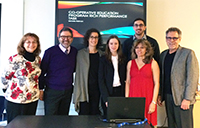A lab at York University is giving high school students a “memorable” opportunity in research through an innovative experiential education program.

Psychology Professor Shayna Rosenbaum has partnered with Richmond Hill High School (RHHS) to bring co-op students into her cognitive neuroscience lab during their placement.
The lab – which studies how memories are represented in the brain – has hosted two co-op students, one in the fall 2014 semester and another in the fall 2015 semester.
The Grade 11 co-op students are brought into research studies involving memory and memory testing, and learn everything from lab ethics to study conceptualization to designing specific testing stimuli.
“We try to expose the high school student to as much of the research process as possible,” said Rosenbaum. “We try to take them through all the steps. They attend regular lab meetings, and they are included as part of the lab team from day one.”

Most recently, co-op student Michelle Raitman worked in the lab with Rosenbaum and her research associate, Alice Kim, investigating how different types of studying practices affect memory and information retrieval in high school students. They exposed Raitman to the question of whether “cramming” or spacing out study material is more effective and efficient for long-term retention of information.
“Research shows that learning and long-term retention of information often doubles when studied items are spaced apart compared to when the items are presented in immediate succession,” Rosenbaum explained, adding that this has clear implications for classroom learning – a topic to which the high school student could easily relate.
Raitman was involved in testing high school students to investigate whether there is an optimal spacing schedule.

She also worked with honours thesis student Jaime Cazes on a study that looks at whether pattern separation, which refers to the ability to encode overlapping events as distinct in memory, occurs for auditory events, as it is most often studied in the visual domain. For the study, she helped create stimuli for an auditory perception and recognition paradigm involving “micro-patterns” of pure tones that repeat or differ slightly in contour or in pitch.
“My upper level students are embracing the co-op students and it’s really benefiting students in the lab because it gives them supervisory experience,” said Rosenbaum. “And, because students in the lab are at different stages, the high school students are learning about university life and career choices. They are gaining a global perspective.”
The previous fall, high school co-op student Gaya Bin Noon was involved in scoring material from a study and transcribing the narratives that participants produced.
“Many students are interested in having a lab-based experience and to gain a sense of what to expect in the next stage of their academic careers” said Rosenbaum. “I’m hoping other high schools, and other labs, will find this to be a useful model.”
The partnership came together when a co-op student expressed interest in memory research and the head of community-based learning at RHHS, a high school of over 2,000 students, reached out to York U.
“It’s a really nice way to expose high school students to York. These are excellent student that we would love to recruit, and they are hand-picked by the co-op program,” said Rosenbaum.
Both students, she reports, have asked to continue with research in the lab.
By Ashley Goodfellow Craig, YFile deputy editor


